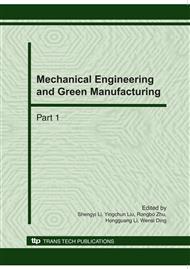[1]
Megally S. H., Silva P. F., Seible F. Seismic response of sacrificial shear keys in bridge abutment,. Rep. to CALTRANS, Contract No. 59A0337, Dept. of Structural Engineering, UC San Diego, San Diego, (2001).
Google Scholar
[2]
Bozorgzadeh A., Megally S.H., Ashford S., Restrepo J.I. Seismic response of sacrificial exterior shear keys in bridge abutments,. Rep. to CALTRANS, Contract No. 59A0337, Dept. of Structural Engineering, UC San Diego, San Diego, (2007).
DOI: 10.1061/(asce)1084-0702(2006)11:5(555)
Google Scholar
[3]
Shervin M. Effect of side retainers on seismic response of bridges with elastomeric bearings,. Journal of Bridge Engineering, Vol. 9, pp.95-100, (2004).
DOI: 10.1061/(asce)1084-0702(2004)9:1(95)
Google Scholar
[4]
Goel R. K., Chopra A. K. Role of shear keys in seismic behavior of bridges crossing fault-rupture zones,. Journal of Bridge Engineering, Vol. 13, pp.398-408, (2008).
DOI: 10.1061/(asce)1084-0702(2008)13:4(398)
Google Scholar
[5]
LI Q., ZHAO S.C. Wenchuan Earthquake engineering damage analysis,. Southwest Jiaotong University Press, Chengdu, China, (2008).
Google Scholar
[6]
WANG D. S., GUO X., SUN Z.G. Damage to highway bridges during Wenchuan Earthquake,. Journal Of Earthquake Engineering And Engineering Vibration. Vol. 29, pp.84-94, (2009).
Google Scholar
[7]
Liu S., Liu J. B., Fang E. The advances of studies on the dynamic contact problem and its numerical methods. Engineering Mechanics, Vol. 16, pp.14-28, (1999).
Google Scholar
[8]
Dahlbuist G. A special stability problem for linear multistep methods', BIT, Vol. 3, pp.27-43, (1963).
Google Scholar
[9]
Hilber H. M. Collocation, dissipation and 'overshoot' for time integration schemes in structural dynamics,. Earthquake Engng Struct. Dyn., Vol. 6, pp.99-117, (1978).
DOI: 10.1002/eqe.4290060111
Google Scholar
[10]
Liu J.B., Wang D. Yao L. A method for calculating the dynamic effect of dynamic and static friction on a contactable crack. Acta Mechanica Sinica, Vol. 26, pp.494-502, (1994).
Google Scholar
[11]
J B Liu, D Wang, L Yao. A contact force model in the dynamic analysis of contactable crack. Acta Mechanica Solida Sinica(English Edition), Vol. 6, pp.439-452, (1993).
Google Scholar
[12]
J B Liu, S K Sharan, D Wang et al. A contact force model for the dynamic response of cracks. Computers &Structures, Vol. 52, pp.659-666, (1994).
DOI: 10.1016/0045-7949(94)90347-6
Google Scholar
[13]
J B Liu, Liu Shu, Du Xiuli. A method for the analysis of dynamic response of structure containing non-smooth contactable interfaces. Acta Mechanica Sinica, Vol. 15, pp.63-72, (1999).
DOI: 10.1007/bf02487902
Google Scholar
[14]
Komodromos P., Polycarpou P. C., Papaloizou L. et al. Response of seismically isolated buildings considering poundings. Earthquake Engng. Struct. Dyn., Vol. 36, pp.1605-1622, (2007).
DOI: 10.1002/eqe.692
Google Scholar
[15]
Anagnostopoulos S. A. Equivalent viscous damping for modeling inelastic impacts in earthquake pounding problems,. Earthquake Engineering And Structural Dynamics, Vol. 33, pp.897-902, (2004).
DOI: 10.1002/eqe.377
Google Scholar
[16]
Komodromos P., Polycarpou P. C., Papaloizou L., et. al. Response of seismically isolated buildings considering poundings,. Earthquake Engng Struct. Dyn., Vol. 36, pp.1605-1622, (2007).
DOI: 10.1002/eqe.692
Google Scholar


